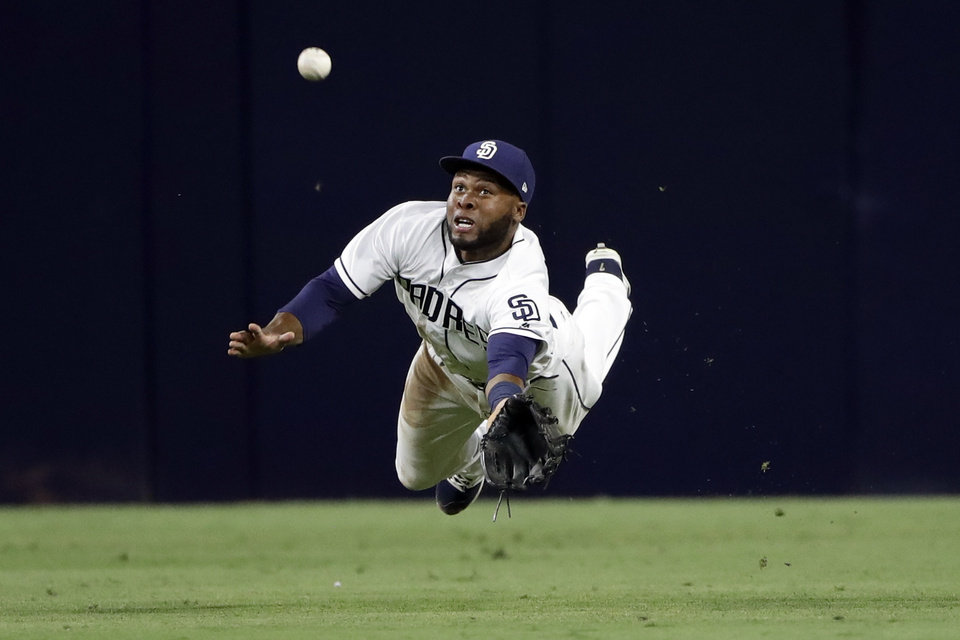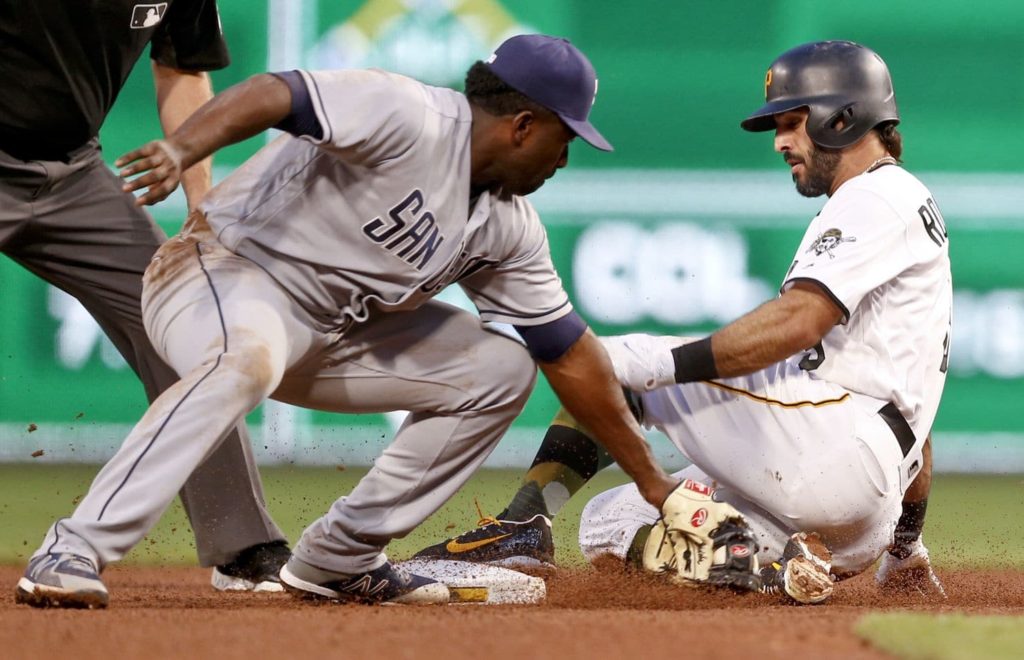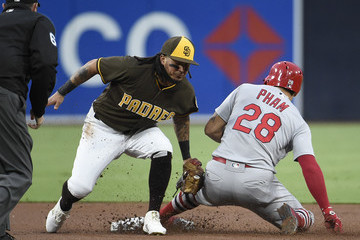The Padres Defense Is Actually Good

(AP Photo/Gregory Bull)

If you just woke up from hibernation and turned on Thursday’s Padres game in Pittsburgh, your initial thought would be that the Padres were among the worst defensive teams in all of Major League Baseball. The Padres made one error and had several adventures with fly balls in the outfield on their way to a 5-4 loss to the Pirates.
However, we must avoid the pitfall of punching walls and raising our blood pressures to unhealthy heights over one game. Baseball is about sample sizes, taking a step back, and looking at the big picture.
The tough loss in Pittsburgh triggered a thought about the Padres’ defense and how it has fared so far this season. The findings themselves are actually encouraging.
Let’s dive into the numbers:
As a team, the Padres have +24 Defensive Runs Saved, good enough for third in the entire league with only the Brewers and Diamondbacks ahead of them. Defensive metrics are tricky and unpolished, which is why the Friars’ -10.5 Ultimate Zone Rating (UZR) is 28th in the league. However, most of the other defensive stats have the Padres, at worst, in the middle of the pack.
The Padres have committed 27 errors as a team, which is 14th in the league. Their 91 double plays turned is 12th and the ten runners thrown out trying to steal is up to seventh-best in baseball. Overall fielding percentage as a team has long been an indicator of how well a team’s defense actually is and the Padres have a .984 fielding percentage, good enough for 15th in the league.
So, before we condemn the Padres for terrible defense, let’s appreciate the fact that, for the most part, the team has actually been solid with their gloves.
Individually, here is a look at each position in terms of Defensive Runs Saved (DRS) and Ultimate Zone Rating (UZR) and where they rank in those categories among their defensive peers.
| C | |
| Austin Hedges | |
| DRS | 4 (2nd) |
| oStr% | 8.9 (9th) |
Catcher is a bit special since they do not calculate UZR. oSTr% is a stat that tracks the percentage of pitches caught outside the strike zone that were actually called strikes. This helps indicate whether or not a catcher is a good “framer.” Hedges has not been healthy this season, but he still ranks among the top 10 in all catchers in both defensive categories.
Now for the rest of the team.
| 1B | ||
| Eric Hosmer | ||
| DRS | 1 (t-5th) | |
| UZR | -2 (28th) |
| 2B | |
| Jose Pirela | |
| DRS | 4 (2nd) |
| UZR | 0.7 (t-11th) |
| SS | ||
| Freddy Galvis | ||
| DRS | 5 (t-4th) | |
| UZR | -0.4 (17th) |
| 3B | ||
| Christian Villanueva | ||
| DRS | 0 (t-6th) | |
| UZR | -3.6 Last | |
| RF | |
| Travis Jankowski | |
| DRS | 2 (t-6th) |
| UZR | 1.1 (14th) |
| CF | ||
| Manuel Margot | ||
| DRS | 5 (3rd) | |
| UZR | -0.3 (21st) | |
| LF | ||
| Franchy Cordero | ||
| DRS | -1 (t-9th) | |
| UZR | -2.1 (39th) | |

| All Padres Pitchers | |
| DRS | 1 (t-5th) |
Breaking this down, most of these players rank among the top half in their respective positions. The outlier is, of course, Christian Villanueva, who has been dreadful at third base. Obviously, there are some discrepancies between DRS and UZR, but using both can give a decent idea of how a player is defensively. Eric Hosmer has four Gold Gloves, but his numbers this season are hit-and-miss.
Franchy Cordero is young and still learning the ropes of playing left field in the shadow of the Western Metal Supply Co. building, thus his poor defensive stats despite his elite athleticism. With time, he should even out and develop into a solid big league defender.
Freddy Galvis has been as sure-handed at short as the Padres could have asked for. Another pleasant surprise has been Jose Pirela, who many believed was unfit for second base. His numbers thus far make that argument invalid. We know the defensive potential and freakish athleticism that Manuel Margot, has, as he too is still learning on the job in center field.
Even the pitchers have been pretty solid, with the fifth-highest DRS in the game.
Of course, it stings to lose a game in a frustrating way, especially because of poor defensive play, but in the grand scheme of things, this young Padres team has been solid with the glove thus far. The most exciting part is that all these players are still progressing and are only going to get better from here.
Native of Escondido, CA. Lived in San Diego area for 20 years. Padres fan since childhood (mid-90s). I have been writing since 2014. I currently live near Seattle, WA and am married to a Seattle sports girl. I wore #19 on my high school baseball team for Tony Gwynn. I am a stats and sports history nerd. I attended BYU on the Idaho campus. I also love Star Wars.
Why such a discrepancy in the two stats? What is the part of the calculation that is causing that?
There isn’t always a huge gap between UZR and DRS but in this instance yes. Here is an explanation on the difference from Fielding Bible:
“Both systems have the same goal- estimate a player’s defensive worth in units of “runs”, and both rely on hit location and play by play data from Baseball Info Solutions. The differences lie in the various adjustments and calculations that are made.
For example, Defensive Runs Saved utilizes the batted ball timer data, while (UZR) relies on the type and velocity categorizations. Defensive Runs Saved also includes components to measure pitcher and catcher defense.
BIS owner John Dewan has specialized in defensive evaluations for decades. While still with STATS, Inc. John developed the original “Zone Rating”, which rates each fielder on his ability to make plays on balls hit inside a pre-determined zone for each position. Shortly after leaving STATS, he began work on a more advanced defensive metric. A metric called “Ultimate Zone Rating” was introduced in the STATS Scoreboard books shortly before Dewan left the company. Dewan’s ongoing research eventually produced the Plus/Minus System.
Shortly thereafter, Mitchel Lichtman began calculating UZR on his own, with additional calculations and small adjustments of his own. Lichtman’s UZR is maintained on Fangraphs.com using the same BIS data.”